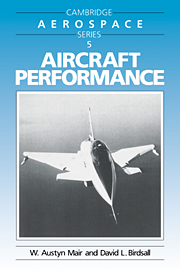Book contents
- Frontmatter
- Contents
- Preface
- Introduction
- 1 Aerodynamic foundations
- 2 Basic flight theory
- 3 Drag equations
- 4 Climbing performance
- 5 Power plants
- 6 Take-off and landing performance
- 7 Fuel consumption, range and endurance
- 8 Turning performance
- 9 Vectored thrust
- 10 Transonic and supersonic flight
- Appendixes
- References
- Index
8 - Turning performance
Published online by Cambridge University Press: 02 December 2009
- Frontmatter
- Contents
- Preface
- Introduction
- 1 Aerodynamic foundations
- 2 Basic flight theory
- 3 Drag equations
- 4 Climbing performance
- 5 Power plants
- 6 Take-off and landing performance
- 7 Fuel consumption, range and endurance
- 8 Turning performance
- 9 Vectored thrust
- 10 Transonic and supersonic flight
- Appendixes
- References
- Index
Summary
In earlier chapters, except in the discussions of the landing flare and the take-off transition immediately after lift-off, it has been assumed that the flight path is straight, so that there is no component of acceleration normal to the flight path. In this chapter flight in a curved path will be considered, concentrating on the usual form of banked turn as shown in Figure 8.1, in which the angle of bank is adjusted so that there is no sideslip and therefore no component of aerodynamic force normal to the plane of symmetry of the aircraft. In such a turn the required lift is greater than the weight, thus CL is greater than it would be in straight and level flight at the same speed and consequently the drag is also greater. This raises the requirement for thrust, even to maintain level flight, and thus the rate of climb obtainable with the maximum available thrust is reduced and may become negative. As the turn becomes tighter and the normal acceleration V2/R is increased, due to either a high speed or a small turn radius, or both, there will be increased demands for CL and for thrust to maintain height, with the consequence that limitations may be imposed by stalling or buffeting or by the engine rating.
This chapter addresses the interdependences among speed, rate of turn, rate of climb and additional ‘g-load’ on the pilot, as well as the limitations on one or other of these when some are fixed.
- Type
- Chapter
- Information
- Aircraft Performance , pp. 214 - 236Publisher: Cambridge University PressPrint publication year: 1992



